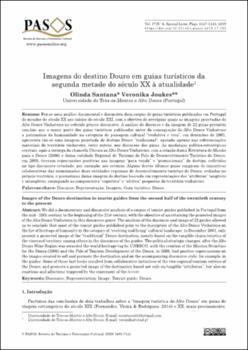Imagens do destino Douro em guias turísticos da segunda metade do século XX à atualidade
Fecha
2019Resumen
Fez ‑se uma análise documental e discursiva dum corpus de guias turísticos publicados em Portugal de meados do século XX aos inícios do século XXI, com o objetivo de averiguar quais as imagens projetadas do Alto Douro Vinhateiro no referido género discursivo. A análise do discurso e da imagem de 22 guias permitiu concluir que a maior parte dos guias turísticos publicados antes da consagração do Alto Douro Vinhateiro a património da humanidade na categoria de paisagem cultural “evolutiva e viva”, em dezembro de 2001, apresenta tão ‑só uma imagem projetada do destino Douro “tradicional”, apoiada apenas nas referenciações materiais do território vinhateiro, entre outros, nos discursos dos guias. As mudanças político ‑estratégicas centrais, após a outorga da chancela Unesco ao Alto Douro Vinhateiro, com a criação duma Estrutura de Missão para o Douro (2006) e duma entidade Regional de Turismo do Polo de Desenvolvimento Turístico do Douro, em 2008, tiveram repercussões positivas nas imagens “para venda” e “promocionais” do destino, refletidas no tipo discursivo estudado, por exemplo, nos roteiros. Alguns destes últimos guias surgiram de iniciativas colaborativas das mencionadas duas entidades regionais de desenvolvimento turístico do Douro, sediadas no próprio território, e promotoras duma imagem do destino baseada em representações dos “atributos” tangíveis e intangíveis, conjugando as componentes “cognitiva” e “afetiva” propostas do território vinhateiro. We did a documentary and discursive analysis of a corpus of tourist guides published in Portugal from the mid ‑ 20th century to the beginning of the 21st century, with the objective of ascertaining the projected images of the Alto Douro Vinhateiro in this discursive genre. The analysis of the discourse and image of 22 guides allowed us to conclude that most of the tourist guides published prior to the inscription of the Alto Douro Vinhateiro on the list of heritage of humanity in the category of “evolving and living” cultural landscape, in December 2001, only present a projected image of the “traditional” Douro destination, merely based on the tangible characteristics of the vineyard territory, among others in the discourses of the guides. The political ‑strategic changes, after the Alto Douro Wine Region was awarded the world heritage tag by UNESCO, with the creation of the Mission Structure for the Douro (2006) and the Pole of Tourism Development of the Douro, in 2008, had positive repercussions on the images created to sell and promote the destination and on the accompanying discursive style, for example, in the guides. Some of these last books resulted from collaborative initiatives of the two regional tourism entities of the Douro, and promote a projected image of the destination based not only on tangible “attributes”, but also on emotions and affections triggered by the enjoyment of the terroir.





